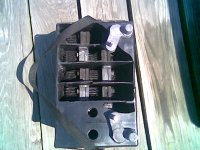 This is a photo of a battery that I blew up. I was hooking up the last few wires before hitting the starter for the first time on my new engines. I was placing wires loosely on the terminal studs as I figured what went where. All went well until I connected the engine ground cable to the engine. BAM, my ears were ringing & everything including me was covered in acid. I was sitting in the bilge between the engines two feet away from it when it blew. Lucky for me my face was turned away. I grabbed the hose off the dock & blasted myself & my brand new engines. I thought, I must have connected something wrong. That was not the case. Apparently one of the first connections was the battery charger. The charger was just doing its job charging the batteries & creating hydrogen gas. When I connected the ground, a loose wire on the battery terminal arced. The rest as they say is history. You can do this stuff thousands of times & get away with it. But every once in awhile things can get real interesting real fast.
This is a photo of a battery that I blew up. I was hooking up the last few wires before hitting the starter for the first time on my new engines. I was placing wires loosely on the terminal studs as I figured what went where. All went well until I connected the engine ground cable to the engine. BAM, my ears were ringing & everything including me was covered in acid. I was sitting in the bilge between the engines two feet away from it when it blew. Lucky for me my face was turned away. I grabbed the hose off the dock & blasted myself & my brand new engines. I thought, I must have connected something wrong. That was not the case. Apparently one of the first connections was the battery charger. The charger was just doing its job charging the batteries & creating hydrogen gas. When I connected the ground, a loose wire on the battery terminal arced. The rest as they say is history. You can do this stuff thousands of times & get away with it. But every once in awhile things can get real interesting real fast.
Home
Outboard Motor Parts
Chrysler outboard parts Evinrude outboard parts Force outboard parts Honda outboard parts Johnson outboard parts Mariner outboard parts Mercury outboard parts Suzuki outboard parts Tohatsu outboard parts Yamaha outboard partsInboard & Sterndrive Engine Parts
Chrysler Marine inboard parts Crusader Marine parts MerCruiser sterndrive parts OMC sterndrive parts Pleasurecraft Marine parts Volvo Penta marine parts + MoreAll Engine Brands
All Manuals HomeOutboard Repair Manuals
Chrysler outboard manuals Evinrude outboard manuals Force outboard manuals Honda outboard manuals Johnson outboard manuals Mariner outboard manualsMercury outboard manuals Nissan outboard manuals Suzuki outboard manuals Tohatsu outboard manuals Yamaha outboard manuals
Inboard & Sterndrive Engine Manuals
MerCruiser sterndrive manuals OMC sterndrive manuals Volvo Penta marine engine manualsPlease Note
MarineEngine.com does not offer troubleshooting assistance or repair advice by email or by telephone.
You are invited to join our public Boat Repair Forum to seek assistance from other members.
You may also visit the Boat Motor Manuals section of our site to obtain a service manual.


